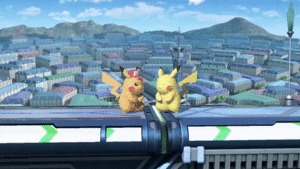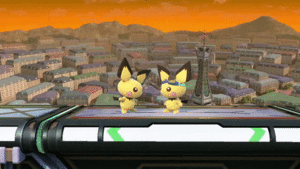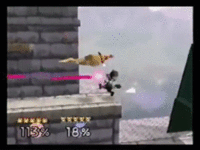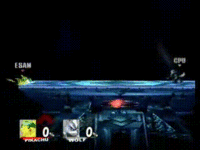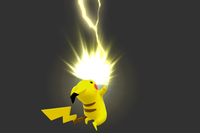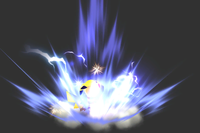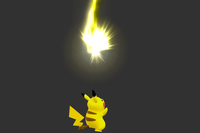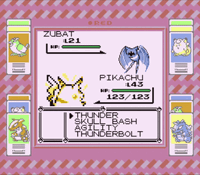Thunder (Pokémon): Difference between revisions
(→Customization: typo) |
m (Text replacement - "(\| *)tab(\d+ *=)" to "$1content$2") |
||
| (11 intermediate revisions by 9 users not shown) | |||
| Line 1: | Line 1: | ||
{{ | {{Title|Thunder (''Pokémon'')}}{{ArticleIcons|allgames=y}} | ||
{{disambig2|[[Pikachu]] and [[Pichu]]'s [[down special]] move|other uses|Thunder (disambiguation)}} | {{disambig2|[[Pikachu]] and [[Pichu]]'s [[down special]] move|other uses|Thunder (disambiguation)}} | ||
{{Infobox Special Move | {{Infobox Special Move | ||
|name=Thunder | |name=Thunder | ||
|image={{tabber|title1=Pikachu| | |image={{tabber|title1=Pikachu|content1=[[File:Pikachu Down B SSBU.gif|300px]]|title2=Pichu|content2=[[File:Pichu Down B SSBU.gif|300px]]}} | ||
|caption=Thunder in ''[[Ultimate]]''. | |caption=Thunder in ''[[Ultimate]]''. | ||
|user=[[Pikachu]] | |user=[[Pikachu]] | ||
| Line 16: | Line 16: | ||
==Overview== | ==Overview== | ||
When used, the Pokémon yells as a bolt of lightning drops from the sky, damaging opponents in the | When used, the Pokémon yells as a bolt of lightning drops from the sky, damaging opponents in the thunderbolt's path. Upon hitting the user, a large shockwave is created, which deals more damage and knockback than the regular bolt, along with granting temporary intangibility to the user (as of ''Brawl''). The lightning blast stalls the user in place for a while, so they can act more quickly if they are not stuck. | ||
==In ''[[Super Smash Bros.]]''== | ==In ''[[Super Smash Bros.]]''== | ||
[[File:SSB64 Greenhouse Combo.gif|thumb|Pikachu performing the [[Greenhouse]] combo which ends with a [[Thunderspike]].]] | [[File:SSB64 Greenhouse Combo.gif|thumb|Pikachu performing the [[Greenhouse]] combo which ends with a [[Thunderspike]].]] | ||
In ''Super Smash Bros.'', Thunder has infinite vertical range and thus can be often used to score [[KO]]'s when an opponent is near the upper [[blast line]]. This technique is called "[[Thunderspiking]]", and can lead to KO's at much lower percents. As a result, {{SSB|Pikachu}} players try to integrate it into their combos as often as they can, typically after an [[up smash]]. Even though the move is powerful, it has considerable ending lag. Regardless, it is considered one of Pikachu's best moves. The thunderbolt deals 12% damage and | In ''Super Smash Bros.'', Thunder has infinite vertical range and thus can be often used to score [[KO]]'s when an opponent is near the upper [[blast line]]. This technique is called "[[Thunderspiking]]", and can lead to KO's at much lower percents. As a result, {{SSB|Pikachu}} players try to integrate it into their combos as often as they can, typically after an [[up smash]]. Even though the move is powerful, it has considerable ending lag. Regardless, it is considered one of Pikachu's best moves. The thunderbolt deals 12% damage and the shockwave deals 16%. Both hits can connect, making Thunder deal 28% when this occurs. Both the thunderbolt and shockwave have very high base knockback but low knockback scaling, making them very effective at KOing near blastzones although they are not quite as effective at KOing from far distances. The shockwave is still a strong KO move regardless, being capable of KOing middleweights under 100% from the center of {{SSB|Dream Land}}. | ||
the shockwave deals 16%. Both hits can connect, making Thunder deal 28% when this occurs. Both the thunderbolt and shockwave have very high base knockback but low knockback scaling, making them very effective at KOing | |||
The move was later buffed in the PAL versions, with both the thunderbolt and shockwave dealing 2% more damage (14%/18% for a total of 32%) which made Thunder even more effective for KOing. | The move was later buffed in the PAL versions, with both the thunderbolt and shockwave dealing 2% more damage (14%/18% for a total of 32%) which made Thunder even more effective for KOing. | ||
{{ | {{clr}} | ||
==In ''[[Super Smash Bros. Melee]]''== | ==In ''[[Super Smash Bros. Melee]]''== | ||
===Pikachu=== | ===Pikachu=== | ||
In ''Super Smash Bros. Melee'', Thunder has seen a few improvements. The thunderbolt has less startup lag and the shockwave now deals 17%, making it stronger than it was in ''Smash 64'' (though still weaker than its PAL incarnation and Pikachu can now no longer connect both the thunderbolt and the shockwave). However, the move has seen some noticeable downgrades, making it less effective than its ''Smash 64'' counterpart. The most noticeable nerf is that the move now strikes from a cloud at a fixed height relative to the user (although this is often not visible unless the stage is rather high). For example, if {{SSBM|Pikachu}} or {{SSBM|Pichu}} is under the upper-middle platform at [[Hyrule Temple]] and uses Thunder, one can see the cloud from where the | In ''Super Smash Bros. Melee'', Thunder has seen a few improvements. The thunderbolt has less startup lag and the shockwave now deals 17%, making it stronger than it was in ''Smash 64'' (though still weaker than its PAL incarnation and Pikachu can now no longer connect both the thunderbolt and the shockwave). However, the move has seen some noticeable downgrades, making it less effective than its ''Smash 64'' counterpart. The most noticeable nerf is that the move now strikes from a cloud at a fixed height relative to the user (although this is often not visible unless the stage is rather high). For example, if {{SSBM|Pikachu}} or {{SSBM|Pichu}} is under the upper-middle platform at [[Hyrule Temple]] and uses Thunder, one can see the cloud from where the thunderbolt is generated, but the lightning will not go through the platform, making the attack useless in that particular location. The thunderbolt is considered to be a [[projectile]] and can be [[reflect]]ed back at Pikachu or absorbed for health (which could not be done in ''Smash 64''). The thunderbolt also now only deals 10% (albeit with increased base knockback) and the move has significantly higher ending lag if Pikachu uses it in the air and the thunderbolt does not hit Pikachu (the shockwave also has slightly higher ending lag). The thunderbolt itself travels much slower and has a limited duration, although the latter point does allow the thunderbolt to hit opponents in the air for a longer time. In general, the move is significantly hindered by ''Melee''{{'}}s universal changes. The introduction of [[DI]], the universal reduction of [[hitstun]] and the universally increased falling speeds have all noticeably hindered Thunder's effectiveness, making the thunderbolt harder to combo into and making it less effective for KO'ing if it does connect. Despite these changes, Thunder still remains a useful move for Pikachu (mainly to score vertical KOes). | ||
===Pichu=== | ===Pichu=== | ||
| Line 38: | Line 33: | ||
==In ''[[Super Smash Bros. Brawl]]''== | ==In ''[[Super Smash Bros. Brawl]]''== | ||
[[File:SSBB Thunder Wall.gif|thumb|Thunder connecting with Pikachu in midair repeatedly in ''Brawl'', showing a wall of Thunders being used as an [[edgeguarding]] technique.]] | [[File:SSBB Thunder Wall.gif|thumb|Thunder connecting with Pikachu in midair repeatedly in ''Brawl'', showing a wall of Thunders being used as an [[edgeguarding]] technique.]] | ||
Thunder in ''Super Smash Bros. Brawl'' functions similarly to its ''Melee'' counterpart, except it has seen numerous improvements. The thunderbolt has less startup lag, as well as less ending lag when used in the air. It can also go through platforms in the upper portion of the move and it last for a much longer time when it hits Pikachu. The shockwave in particular however has seen numerous improvements. The shockwave have much less ending lag, as well as a bigger hitbox. The thunderbolt is now active for most of the shockwave's animation, so even when the shockwave's hitboxes end, the thunderbolt can still easily hit opponents. Pikachu is now also [[intangible]] for a period of time while performing the shockwave. The only downside the shockwave has comapred to ''Melee'' is its shorter hitbox duration, although its other improvements more than make up for it. Both the thunderbolt and shockwave retain their power from ''Melee'' however, they are noticeably more effective at KOing due to numerous universal changes (including the universally decreased falling speeds, the changes to the [[Sakurai angle]] and the introduction of the [[gravity]] penalty). It can KO middleweight characters as low as 45% if executed near enough to the blastzone. Even the changes to [[air dodge]]s and the introduction of [[hitstun cancelling]] do not effect the move too much as the thunderbolt can easily beat out air dodges. As a result, Thunderspiking has become a more powerful and effective strategy. | Thunder in ''Super Smash Bros. Brawl'' functions similarly to its ''Melee'' counterpart, except it has seen numerous improvements. The thunderbolt has less startup lag, as well as less ending lag when used in the air. It can also go through platforms in the upper portion of the move and it last for a much longer time when it hits Pikachu. The shockwave in particular however has seen numerous improvements. The shockwave have much less ending lag, as well as a bigger hitbox. The thunderbolt is now active for most of the shockwave's animation, so even when the shockwave's hitboxes end, the thunderbolt can still easily hit opponents. Pikachu is now also [[intangible]] for a period of time while performing the shockwave. The only downside the shockwave has comapred to ''Melee'' is its shorter hitbox duration, although its other improvements more than make up for it. Both the thunderbolt and shockwave retain their power from ''Melee'' however, they are noticeably more effective at KOing due to numerous universal changes (including the universally decreased falling speeds, the changes to the [[Sakurai angle]] and the introduction of the [[gravity]] penalty). It can KO middleweight characters as low as 45% if executed near enough to the blastzone. Even the changes to [[air dodge]]s and the introduction of [[hitstun cancelling]] do not effect the move too much as the thunderbolt can easily beat out air dodges. As a result, Thunderspiking has become a more powerful and effective strategy. | ||
An interesting property of this is that if this attack connects with Pikachu in mid-air, Pikachu will bounce upwards a bit. This was present in the previous games but is much more useful in ''Brawl'', as the shockwave has much less ending lag. Due to its startup time, it won't aid much in recovery, but is useful to [[guard break]], especially against spikers. If used near the edge of a stage, the Thunder can create a wall of electricity to prevent a recovering opponent (especially if [[Thunder Jolt]]s are sent out beforehand), best if they try to go for the ledge. | An interesting property of this is that if this attack connects with Pikachu in mid-air, Pikachu will bounce upwards a bit. This was present in the previous games but is much more useful in ''Brawl'', as the shockwave has much less ending lag. Due to its startup time, it won't aid much in recovery, but is useful to [[guard break]], especially against spikers. If used near the edge of a stage, the Thunder can create a wall of electricity to prevent a recovering opponent (especially if [[Thunder Jolt]]s are sent out beforehand), best if they try to go for the ledge. | ||
===Reverse Thunder=== | ===Reverse Thunder=== | ||
[[File:SSBB Thunder Wavebounce.gif|thumb|{{Sm|ESAM}} using {{SSBB|Pikachu}} to wavebounce after a [[wall jump]] off the lip of {{SSBB|Final Destination}} to steer onto the stage while using Thunder so that it covers the area just next to the [[edge]] offstage to [[edgeguard]].]] | [[File:SSBB Thunder Wavebounce.gif|thumb|{{Sm|ESAM}} using {{SSBB|Pikachu}} to wavebounce after a [[wall jump]] off the lip of {{SSBB|Final Destination}} to steer onto the stage while using Thunder so that it covers the area just next to the [[edge]] offstage to [[edgeguard]].]] | ||
In ''Brawl'', Thunder can be reversed by pushing the [[control stick]]/[[d-pad]] in the opposite direction in the first few [[frame]]s. Though useless on the ground, when performed in midair with momentum, the momentum will be reversed, pushing Pikachu in the opposite direction. The technique was retained in later instalments but it is less useful overall. | In ''Brawl'', Thunder can be reversed by pushing the [[control stick]]/[[d-pad]] in the opposite direction in the first few [[frame]]s. Though useless on the ground, when performed in midair with momentum, the momentum will be reversed, pushing Pikachu in the opposite direction. The technique was retained in later instalments but it is less useful overall. | ||
{{ | {{clr}} | ||
==In ''[[Super Smash Bros. 4]]''== | ==In ''[[Super Smash Bros. 4]]''== | ||
The move returns in ''Super Smash Bros. 4'' albeit with some significant changes. Most of the changes it received were for the worse overall. One positive change is that if Pikachu is hit out of the startup animation (starting from frame 2), the thunderbolt will still come out. While this was technically in the previous two games, this would only occur if Pikachu was hit out of the move the frame before the thunderbolt is supposed to come out but now, it will come out regardless of when Pikachu is hit (except for the first frame). This noticeably improves the move's utility as a combo breaker. Most other changes however are either a mixed bag or purely negative. | |||
The move returns in ''Super Smash Bros. 4'' albeit with some significant changes. Most of the changes it received were for the worse overall. One positive change is that if Pikachu is hit out of the startup animation (starting from frame 2), the thunderbolt will still come out. While this was technically in the previous two games, this would only occur if Pikachu was hit out of the move the frame before the thunderbolt is supposed to come out but now, it will come out regardless of when Pikachu is hit (except for the first frame). This noticeably improves the move's utility as a combo breaker. Most other changes however are either a mixed bag or purely negative. | |||
The most notable change is that the Thundercloud is positioned much lower. This gives Thunder much less vertical range and naturally makes Thunderspiking much harder to perform. Thunder now has a meteor smash hitbox as the cloud spawns. This meteor smash can link into the shockwave however, the meteor smash is unreliable as a KO move, and it makes Thunderspiking much harder to perform along with Thunder's reduced height. In addition, the meteor smash does not always lead into the shockwave, making it unreliable (although this can be used for edgeguarding off stage). The thunderbolt is now much weaker which along with the previous two changes, hinders the effectiveness of Thunderspiking. The thunderbolt itself travels faster which enables it to hit Pikachu much sooner (when combined with the cloud's reduced height) but shortens its duration. The shockwave itself has noticeably decreased power, as well as increased ending lag (although it has slightly increased intangibility). In addition to this, the thunderbolt no longer remains active when it hits Pikachu, significantly shortening its duration, and making the shockwave easier to punish. | The most notable change is that the Thundercloud is positioned much lower. This gives Thunder much less vertical range and naturally makes Thunderspiking much harder to perform. Thunder now has a meteor smash hitbox as the cloud spawns. This meteor smash can link into the shockwave however, the meteor smash is unreliable as a KO move, and it makes Thunderspiking much harder to perform along with Thunder's reduced height. In addition, the meteor smash does not always lead into the shockwave, making it unreliable (although this can be used for edgeguarding off stage). The thunderbolt is now much weaker which along with the previous two changes, hinders the effectiveness of Thunderspiking. The thunderbolt itself travels faster which enables it to hit Pikachu much sooner (when combined with the cloud's reduced height) but shortens its duration. The shockwave itself has noticeably decreased power, as well as increased ending lag (although it has slightly increased intangibility). In addition to this, the thunderbolt no longer remains active when it hits Pikachu, significantly shortening its duration, and making the shockwave easier to punish. | ||
As a result of these changes, Thunder cannot KO nearly as early as it could before and it is overall less reliable and versatile although it still remains a useful move despite its nerfs as Pikachu is still capable of comboing into it for decently early KOes. | As a result of these changes, Thunder cannot KO nearly as early as it could before and it is overall less reliable and versatile although it still remains a useful move despite its nerfs as Pikachu is still capable of comboing into it for decently early KOes. | ||
==In ''[[Super Smash Bros. Ultimate]]''== | ==In ''[[Super Smash Bros. Ultimate]]''== | ||
===Pikachu=== | ===Pikachu=== | ||
Pikachu's | Pikachu's Thunder in ''Super Smash Bros. Ultimate'' remains similar to how it worked in ''Smash 4'', although it has seen two improvements. Firstly, the meteor smash hitbox now has set knockback, which makes it link into the shockwave more reliably. Secondly, the shockwave deals noticeably higher knockback, improving its KO potential. While it is still not as powerful as it was in games prior to ''Smash 4'', it is still a decently powerful KO move overall. As a result of these changes, Pikachu's Thunder is essentially like it was in ''Smash 4'' but it is superior overall due to its greater KO potential. | ||
===Pichu=== | ===Pichu=== | ||
| Line 71: | Line 60: | ||
==Instructional quotes== | ==Instructional quotes== | ||
{{InstructionalQuotes | {{InstructionalQuotes | ||
|ssbmcount= | |ssbmcount=1 | ||
|ssbmchar=Pikachu | |ssbmchar=Pikachu | ||
|ssbmdesc=Call thunderbolts down from the sky. They won't pass through terrain obstacles. | |ssbmdesc=Call thunderbolts down from the sky. They won't pass through terrain obstacles. | ||
|ssbbcount=1 | |ssbbcount=1 | ||
|ssbbchar=Pikachu | |ssbbchar=Pikachu | ||
| Line 91: | Line 78: | ||
==Customization== | ==Customization== | ||
Special Move customization was added in ''[[Super Smash Bros. 4]]''. These are the variations: | Special Move customization was added in ''[[Super Smash Bros. 4]]''. These are the variations: | ||
{{CustomSet|Pikachu|Down|name1=Thunder|desc1=A lightning strike that deals more damage to opponents if the bolt hits you.|name2=Thunder Burst|desc2=An electrical burst around you that sends opponents flying.|name3=Distant Thunder|desc3=The thundercloud will appear higher up. Deals more damage near the cloud.|altlink1=Thunder (Pikachu)}} | {{CustomSet|Pikachu|Down|name1=Thunder|desc1-ntsc=A lightning strike that deals more damage to opponents if the bolt hits you.|desc1-pal=Triggers a lightning strike. If the bolt hits you, it creates a discharge that does extra damage.|name2=Thunder Burst|desc2-ntsc=An electrical burst around you that sends opponents flying.|desc2-pal=Triggers an electrical burst around you that sends opponents flying back.|name3=Distant Thunder|desc3-ntsc=The thundercloud will appear higher up. Deals more damage near the cloud.|desc3-pal=Triggers a longer bolt of lightning that deals more damage at its top than at the bottom.|altlink1=Thunder (Pikachu)}} | ||
# '''Thunder''': Default. | # '''Thunder''': Default. | ||
# '''Thunder Burst''': Creates an electrical burst around Pikachu, lacking a thunderbolt, but it deals more damage and knockback. It has two initial hits which deal 2% each and a final hit which deals 15% up close and 12% from afar. The near hit is almost as powerful as Pikachu's ''Melee''/''Brawl'' shockwave although the far hit is much weaker. The first two hits do not link reliably into the third hit and the move is overall very slow and laggy. {{Main|Pikachu (SSB4)/Down special/Custom 1}} | # '''Thunder Burst''': Creates an electrical burst around Pikachu, lacking a thunderbolt, but it deals more damage and knockback. It has two initial hits which deal 2% each and a final hit which deals 15% up close and 12% from afar. The near hit is almost as powerful as Pikachu's ''Melee''/''Brawl'' shockwave although the far hit is much weaker. The first two hits do not link reliably into the third hit and the move is overall very slow and laggy. {{Main|Pikachu (SSB4)/Down special/Custom 1}} | ||
| Line 106: | Line 93: | ||
==Origin== | ==Origin== | ||
[[File:PikachuThunderRBY.gif|thumb|{{ | [[File:PikachuThunderRBY.gif|thumb|{{iw|bulbapedia|Thunder|move}} being used by Pikachu in ''{{iw|bulbapedia|Pokémon Red}}''.]] | ||
Thunder is a powerful special Electric-type attack introduced in {{iw|bulbapedia|Generation I}}. It has a base power of 120 (nerfed to 110 in {{iw|bulbapedia|Generation VI}}) but has relatively low accuracy, which causes it to be very unreliable, dealing less damage than Thunderbolt or Discharge on average. It can also hit Pokémon that are preparing to use [[Fly]], while most other attacks fail against them; this is referenced in ''Smash'' through its long vertical hitbox. Certain weather effects can also decrease or increase its accuracy; in rain, Thunder skips accuracy checks entirely and even sometimes hit through {{iw|bulbapedia|Protect|move}} in Generation IV due to a glitch. | |||
In every generation, Pikachu is able to learn Thunder though leveling up, usually being one of the last moves it learns that way. Pikachu can also learn the move via {{ | In every generation, Pikachu is able to learn Thunder though leveling up, usually being one of the last moves it learns that way. Pikachu can also learn the move via {{iw|bulbapedia|TM25}} in every generation so far; this TM is also the only way Pichu can learn the move. In {{iw|bulbapedia|Pokémon Red and Green}}, Pikachu learns Thunder at level 43, which was reduced to 41 in {{iw|bulbapedia|Pokémon Yellow}}. | ||
<gallery> | <gallery> | ||
Thunder.png|Thunder in Generation VII ''Pokémon'' games. | |||
</gallery> | </gallery> | ||
{{clrl}} | {{clrl}} | ||
| Line 118: | Line 105: | ||
==Gallery== | ==Gallery== | ||
<gallery> | <gallery> | ||
Thunder SSB.png|Pikachu's Thunder in ''Smash 64''. | |||
Thunder Melee.jpg|Pikachu's Thunder in ''Melee''. | |||
Pichu Thunder.jpg|Pichu's Thunder in ''Melee''. | |||
Pikachu Thunder air.png|Pikachu's Thunder in ''Brawl'' | |||
ThunderSSB4.png|Pikachu's Thunder in ''Wii U''. | ThunderSSB4.png|Pikachu's Thunder in ''Wii U''. | ||
Pikachu Thunder Combo SSB4.jpg|Meteor smashing with Thunder. | |||
Pikachu SSBU Skill Preview Down Special.png|Pikachu using Thunder as shown by the [[Move List]] in ''Ultimate''. | Pikachu SSBU Skill Preview Down Special.png|Pikachu using Thunder as shown by the [[Move List]] in ''Ultimate''. | ||
Pichu SSBU Skill Preview Down Special.png|Pichu using Thunder as shown by the Move List in ''Ultimate''. | Pichu SSBU Skill Preview Down Special.png|Pichu using Thunder as shown by the Move List in ''Ultimate''. | ||
| Line 141: | Line 128: | ||
|zh={{rollover|打雷|Dǎléi|?}} | |zh={{rollover|打雷|Dǎléi|?}} | ||
}} | }} | ||
==Technical details== | |||
Pikachu: | |||
*[[Pikachu (SSB)/Down special]] | |||
*[[Pikachu (SSBM)/Down special]] | |||
*[[Pikachu (SSBB)/Down special]] | |||
*[[Pikachu (SSB4)/Down special]] | |||
*[[Pikachu (SSBU)/Down special]] | |||
Pichu: | |||
*[[Pichu (SSBM)/Down special]] | |||
*[[Pichu (SSBU)/Down special]] | |||
{{Multiple Special Moves|Pikachu|Pichu}} | {{Multiple Special Moves|Pikachu|Pichu}} | ||
| Line 156: | Line 154: | ||
[[Category:Pichu (SSBM)]] | [[Category:Pichu (SSBM)]] | ||
[[Category:Pichu (SSBU)]] | [[Category:Pichu (SSBU)]] | ||
[[es:Trueno (Pokémon)]] | |||
Latest revision as of 08:23, October 30, 2023
| Thunder | |
|---|---|
Thunder in Ultimate. | |
| Users | Pikachu Pichu |
| Universe | Pokémon |
| Article on Bulbapedia | Thunder (move) |
Thunder (かみなり, Thunder) is Pikachu and Pichu's down special move. It is not to be confused with Robin's neutral special move of the same name.
Overview[edit]
When used, the Pokémon yells as a bolt of lightning drops from the sky, damaging opponents in the thunderbolt's path. Upon hitting the user, a large shockwave is created, which deals more damage and knockback than the regular bolt, along with granting temporary intangibility to the user (as of Brawl). The lightning blast stalls the user in place for a while, so they can act more quickly if they are not stuck.
In Super Smash Bros.[edit]
In Super Smash Bros., Thunder has infinite vertical range and thus can be often used to score KO's when an opponent is near the upper blast line. This technique is called "Thunderspiking", and can lead to KO's at much lower percents. As a result, Pikachu players try to integrate it into their combos as often as they can, typically after an up smash. Even though the move is powerful, it has considerable ending lag. Regardless, it is considered one of Pikachu's best moves. The thunderbolt deals 12% damage and the shockwave deals 16%. Both hits can connect, making Thunder deal 28% when this occurs. Both the thunderbolt and shockwave have very high base knockback but low knockback scaling, making them very effective at KOing near blastzones although they are not quite as effective at KOing from far distances. The shockwave is still a strong KO move regardless, being capable of KOing middleweights under 100% from the center of Dream Land.
The move was later buffed in the PAL versions, with both the thunderbolt and shockwave dealing 2% more damage (14%/18% for a total of 32%) which made Thunder even more effective for KOing.
In Super Smash Bros. Melee[edit]
Pikachu[edit]
In Super Smash Bros. Melee, Thunder has seen a few improvements. The thunderbolt has less startup lag and the shockwave now deals 17%, making it stronger than it was in Smash 64 (though still weaker than its PAL incarnation and Pikachu can now no longer connect both the thunderbolt and the shockwave). However, the move has seen some noticeable downgrades, making it less effective than its Smash 64 counterpart. The most noticeable nerf is that the move now strikes from a cloud at a fixed height relative to the user (although this is often not visible unless the stage is rather high). For example, if Pikachu or Pichu is under the upper-middle platform at Hyrule Temple and uses Thunder, one can see the cloud from where the thunderbolt is generated, but the lightning will not go through the platform, making the attack useless in that particular location. The thunderbolt is considered to be a projectile and can be reflected back at Pikachu or absorbed for health (which could not be done in Smash 64). The thunderbolt also now only deals 10% (albeit with increased base knockback) and the move has significantly higher ending lag if Pikachu uses it in the air and the thunderbolt does not hit Pikachu (the shockwave also has slightly higher ending lag). The thunderbolt itself travels much slower and has a limited duration, although the latter point does allow the thunderbolt to hit opponents in the air for a longer time. In general, the move is significantly hindered by Melee's universal changes. The introduction of DI, the universal reduction of hitstun and the universally increased falling speeds have all noticeably hindered Thunder's effectiveness, making the thunderbolt harder to combo into and making it less effective for KO'ing if it does connect. Despite these changes, Thunder still remains a useful move for Pikachu (mainly to score vertical KOes).
Pichu[edit]
For Pichu, Pichu's thunderbolt strikes multiple times and has lower and slightly more upward knockback than Pikachu's. Each hit deals 4% damage for a total of 15%. The move does not deal recoil damage if Pichu does not hit itself, making it the only electrically charged attack Pichu has that might not damage itself. The shockwave deals 13% damage and is noticeably weaker than Pikachu's, in addition to dealing 3% recoil damage to Pichu. Pichu can connect both the thunderbolt and shockwave unlike Pikachu, although the thunderbolt hitboxes will override the shockwave (unlike Pikachu's in Smash 64 where the opposite is true).
In Super Smash Bros. Brawl[edit]
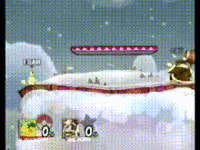
Thunder in Super Smash Bros. Brawl functions similarly to its Melee counterpart, except it has seen numerous improvements. The thunderbolt has less startup lag, as well as less ending lag when used in the air. It can also go through platforms in the upper portion of the move and it last for a much longer time when it hits Pikachu. The shockwave in particular however has seen numerous improvements. The shockwave have much less ending lag, as well as a bigger hitbox. The thunderbolt is now active for most of the shockwave's animation, so even when the shockwave's hitboxes end, the thunderbolt can still easily hit opponents. Pikachu is now also intangible for a period of time while performing the shockwave. The only downside the shockwave has comapred to Melee is its shorter hitbox duration, although its other improvements more than make up for it. Both the thunderbolt and shockwave retain their power from Melee however, they are noticeably more effective at KOing due to numerous universal changes (including the universally decreased falling speeds, the changes to the Sakurai angle and the introduction of the gravity penalty). It can KO middleweight characters as low as 45% if executed near enough to the blastzone. Even the changes to air dodges and the introduction of hitstun cancelling do not effect the move too much as the thunderbolt can easily beat out air dodges. As a result, Thunderspiking has become a more powerful and effective strategy.
An interesting property of this is that if this attack connects with Pikachu in mid-air, Pikachu will bounce upwards a bit. This was present in the previous games but is much more useful in Brawl, as the shockwave has much less ending lag. Due to its startup time, it won't aid much in recovery, but is useful to guard break, especially against spikers. If used near the edge of a stage, the Thunder can create a wall of electricity to prevent a recovering opponent (especially if Thunder Jolts are sent out beforehand), best if they try to go for the ledge.
Reverse Thunder[edit]
In Brawl, Thunder can be reversed by pushing the control stick/d-pad in the opposite direction in the first few frames. Though useless on the ground, when performed in midair with momentum, the momentum will be reversed, pushing Pikachu in the opposite direction. The technique was retained in later instalments but it is less useful overall.
In Super Smash Bros. 4[edit]
The move returns in Super Smash Bros. 4 albeit with some significant changes. Most of the changes it received were for the worse overall. One positive change is that if Pikachu is hit out of the startup animation (starting from frame 2), the thunderbolt will still come out. While this was technically in the previous two games, this would only occur if Pikachu was hit out of the move the frame before the thunderbolt is supposed to come out but now, it will come out regardless of when Pikachu is hit (except for the first frame). This noticeably improves the move's utility as a combo breaker. Most other changes however are either a mixed bag or purely negative.
The most notable change is that the Thundercloud is positioned much lower. This gives Thunder much less vertical range and naturally makes Thunderspiking much harder to perform. Thunder now has a meteor smash hitbox as the cloud spawns. This meteor smash can link into the shockwave however, the meteor smash is unreliable as a KO move, and it makes Thunderspiking much harder to perform along with Thunder's reduced height. In addition, the meteor smash does not always lead into the shockwave, making it unreliable (although this can be used for edgeguarding off stage). The thunderbolt is now much weaker which along with the previous two changes, hinders the effectiveness of Thunderspiking. The thunderbolt itself travels faster which enables it to hit Pikachu much sooner (when combined with the cloud's reduced height) but shortens its duration. The shockwave itself has noticeably decreased power, as well as increased ending lag (although it has slightly increased intangibility). In addition to this, the thunderbolt no longer remains active when it hits Pikachu, significantly shortening its duration, and making the shockwave easier to punish.
As a result of these changes, Thunder cannot KO nearly as early as it could before and it is overall less reliable and versatile although it still remains a useful move despite its nerfs as Pikachu is still capable of comboing into it for decently early KOes.
In Super Smash Bros. Ultimate[edit]
Pikachu[edit]
Pikachu's Thunder in Super Smash Bros. Ultimate remains similar to how it worked in Smash 4, although it has seen two improvements. Firstly, the meteor smash hitbox now has set knockback, which makes it link into the shockwave more reliably. Secondly, the shockwave deals noticeably higher knockback, improving its KO potential. While it is still not as powerful as it was in games prior to Smash 4, it is still a decently powerful KO move overall. As a result of these changes, Pikachu's Thunder is essentially like it was in Smash 4 but it is superior overall due to its greater KO potential.
Pichu[edit]
Pichu's variant, while retaining its recoil damage (now dealing more recoil damage than in Melee as of version 3.1.0), has heavily been changed from Melee, to make it more similar to Pikachu's. The thunderbolt now only hits once, and has gained a meteor smash hitbox, akin to Pikachu's Thunder. The move is much faster (now being even faster than Pikachu's) although much like with Pikachu, the thunderbolt does not have as much vertical range, and it has a much shorter duration. Pichu's thunderbolt remains extremely weak, so it cannot reliably Thunderspike at all. Pichu's shockwave deals more damage and has increased knockback compared to its Melee counterpart (as well as gaining intangibility and having much less ending lag) although it is still weaker than Pikachu's. An interesting thing to note is that when Pichu connects the shockwave, it will always launch opponents in the direction Pichu is facing. This is not the case with Pikachu's. Pichu's thunder has overall become a more useful move as it is much faster, more reliable and more powerful than it was in Melee.
Instructional quotes[edit]
| Call thunderbolts down from the sky. They won't pass through terrain obstacles. | ||
| Call forth a huge bolt of lightning that shoots straight down. It does not travel through platforms. | ||
| Call down lightning to strike opponents. | ||
| Calls down a lightning strike that deals more damage to opponents if the bolt hits Pikachu. | ||
| Calls down thunder from above to hurt nearby opponents. However, Pichu also takes a small amount of damage. |
Customization[edit]
Special Move customization was added in Super Smash Bros. 4. These are the variations:
- Thunder: Default.
- Thunder Burst: Creates an electrical burst around Pikachu, lacking a thunderbolt, but it deals more damage and knockback. It has two initial hits which deal 2% each and a final hit which deals 15% up close and 12% from afar. The near hit is almost as powerful as Pikachu's Melee/Brawl shockwave although the far hit is much weaker. The first two hits do not link reliably into the third hit and the move is overall very slow and laggy.
- Distant Thunder: The Thundercloud appears higher up (equally as high as Thunder in Melee/Brawl). More damage is dealt near the cloud, but the move is noticeably slower, the thunderbolt gets much weaker as it goes down and the thunderbolt loses its ability to meteor smash opponents. Due to higher cloud and stronger thunderbolt, Thunderspiking can be done much more effectively. The move has a shockwave although it is incredibly weak.
Use by other Pokémon[edit]
There are also Pokémon other than Pikachu and Pichu that have used Thunder:
- Rayquaza - In Brawl, when Rayquaza is brought down to low HP levels during the Boss fight against it, Rayquaza may use Thunder. Rayquaza will fly up, circle a few times, then let a thunderbolt loose beneath it. This attack can break shields easily due to its quick consecutive hits, and can bring characters upward, but does not have any real knockback, despite causing high damage.
Origin[edit]
Thunder is a powerful special Electric-type attack introduced in Generation I. It has a base power of 120 (nerfed to 110 in Generation VI) but has relatively low accuracy, which causes it to be very unreliable, dealing less damage than Thunderbolt or Discharge on average. It can also hit Pokémon that are preparing to use Fly, while most other attacks fail against them; this is referenced in Smash through its long vertical hitbox. Certain weather effects can also decrease or increase its accuracy; in rain, Thunder skips accuracy checks entirely and even sometimes hit through Protect in Generation IV due to a glitch.
In every generation, Pikachu is able to learn Thunder though leveling up, usually being one of the last moves it learns that way. Pikachu can also learn the move via TM25 in every generation so far; this TM is also the only way Pichu can learn the move. In Pokémon Red and Green, Pikachu learns Thunder at level 43, which was reduced to 41 in Pokémon Yellow.
Gallery[edit]
Pikachu using Thunder as shown by the Move List in Ultimate.
Names in other languages[edit]
| Language | Name |
|---|---|
| かみなり | |
| Thunder | |
| Fatal-Foudre | |
| Donner | |
| Trueno | |
| Tuono | |
| 打雷 | |
| 번개 | |
| Donder | |
| Гром |
Technical details[edit]
Pikachu:
- Pikachu (SSB)/Down special
- Pikachu (SSBM)/Down special
- Pikachu (SSBB)/Down special
- Pikachu (SSB4)/Down special
- Pikachu (SSBU)/Down special
Pichu:
